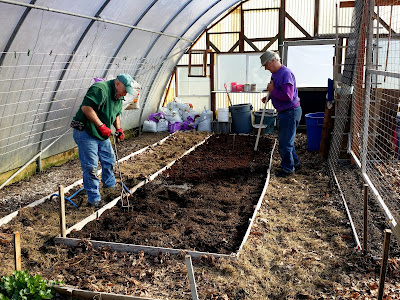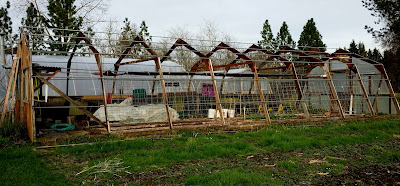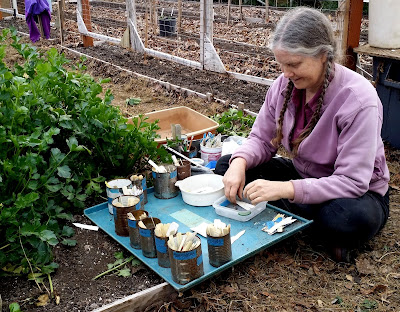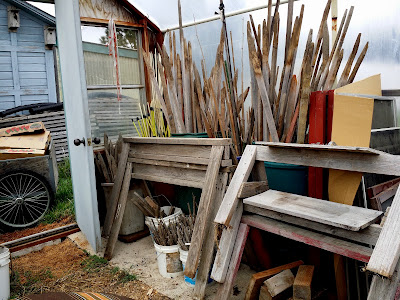We're re-posting this winter update from winter 2024 as it has relevant links and info about winter tasks and projects. Enjoy!
Greetings dear friends, the worst of winter is probably over for us here in the Willamette Valley of Oregon (Zone 7b). Chris and I have had a restful time since the hubbub of fall harvests, seed and food preservation and garden-clean-up are behind us. Here is a photo essay showing how our winters are spent in preparation for spring's promise in the new year.
 |
| Late fall: Sandra sifts the compost that the worms produce in our paths while Chris harvests it. To learn more about creating soil-fertility using local materials, CLICK HERE. |
Winter is the time when we begin adding wood-ash and coffee-grounds to our greenhouse beds and paths. The wood-ash is from our wood-stove (our only source of heat). Coffee grounds are a 'waste product' that our friend John Kinsey collects weekly from a coffee-shop. Worms love them! LINK-Coffee grounds and Wood-ash for fertility
 |
| Spreading coffee. |
 |
| Spreading ashes. |
 |
| Donn and Chris loosen the soil in our greenhouse raised-beds and dig in the ashes, coffee-grounds and worm-compost so beds are ready for spring planting. |
Now is the time to re-plant bulb/root crops to grow seed crops. Beets, carrots and onions are biennials. This means they produce seeds in their second year and then die. Because our ground can be so wet and cold through the winter, we often dig up these root crops and store them in a plastic bag or clam-shell container with dried leaves or straw so they stay moist (but not too moist) till we're ready to replant them. Below are pictures of beets (left) that have wintered over and are beginning to sprout leaves and root hairs. These we plant into pots with soil. On the right is a picture of a row of potted root crops that are developing enough roots and sprouts to then be planted again in the ground so they can mature and set seeds. Note: seed-saving can only be done with heirloom/non-hybrid varieties.
Our oldest greenhouse, the Ark, was ready for re-skinning this winter. The special UV-protected greenhouse plastic is guaranteed for four years but this skin actually lasted seven! We timed the removal of the skin for a few days that were forecast to be mild and with minimal wind. Donn came by after we got the skin off and the three of us got the new one secured in place with lathe in just a few short hours. LINK: Carport-Frame Greenhouse Design
 |
| The Ark with no "skin". |
 |
| Chris and Donn screw down strips of cedar lathe. |
 | |
| That's the newly covered Ark on the left and last year's greenhouse project, The Phoenix, on the right. |
 |
| The Phoenix: spreading mulch and coffee (buckets in foreground) for a new season. |
Winter is the time for organizing our indoor spaces, sorting seeds and labels, pruning perennials and planting new ones...
 |
| After sorting seeds into categories, we put them in zip-lock bags (freezer bags) inside tightly fitting old peanut-butter jars (so they won't get dehydrated) and put them in our chest-freezer. |
 |
| Llyn, sorting plant labels. |
 |
| Keeping our garden supplies sorted and stored out of the weather... |
 |
| Since we shut down our irrigation lines in the winter, we collect rain-water in buckets so we don't have to turn the lines back on till springtime. |
Winter is time to care for our perennial plants: trees, shrubs, vines and flowers. Some need pruning. Some need mulching and our new ones need holes dug so they can live in their 'forever homes'.
 |
| Potted perennials protected from cold, north winds behind the house and under bags of leaves for insulation. These will get planted in the ground soon. |
May this be a fruitful and abundant year!
Other Posts you might be interested in:
 Planting Cool-weather crops:
Planting Cool-weather crops:Reprinted from February 2021: Since we have several greenhouses, February is the time for starting the cool-loving crops like lettuce, cabbage, kale, broccoli, collards, celery, parsley, onions and peas. Here is a post with links to some previously written articles about how to start some of these crops in your own garden.








Great step-by-step garden prep photos. I'm inspired! Many thanks.
ReplyDelete